Keyhole Surgery for Inguinal and Femoral Hernia in Adults
What is a hernia? What are inguinal and femoral hernias?
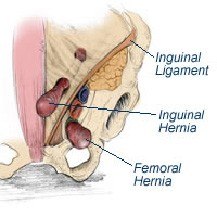
A hernia is a protrusion of an organ or body part through the wall of a cavity in which it is normally enclosed. Inguinal and femoral hernias, are groin hernias, in which a part of the abdominal contents, either bowel or fatty tissue, protrudes through the abdominal wall at the inguinal or femoral canal and comes out just below the skin. These hernias are very common, occurring in up to 10% of males, but are much less common in females. Femoral hernias are more common in women than men, but are much less common than inguinal hernias.
What causes a femoral and inguinal hernia?
Hernias that occur in childhood or adolescence are probably congenital. In adults, a hernia is usually acquired. Although not well proven, it is thought that occupations involving heavy lifting or manual work increase the chance of developing a hernia. Cigarette smoking, chronic constipation, obesity, prostate disease and chronic coughing are also thought to predispose to hernia formation. In many patients, none of these factors are present and the development of a hernia is thought to be related to the fact that the inguinal and femoral canals are natural areas of weakness in the body wall.
What are the signs and symptoms of a femoral and inguinal hernia?
The most common sign of a hernia is the presence of a lump in the groin. Sometimes hernias can be painful, but small hernias may be unexpectedly detected at a routine examination. The most serious complication of a groin hernia is strangulation, which occurs when a segment of the bowel gets caught in the hernia and becomes obstructed or even gangrenous.
How is a femoral and inguinal hernia diagnosed?
A hernia is commonly diagnosed by a simple physical examination by your doctor. In some cases, ultrasound examination of the groin is ordered, but most surgeons are sceptical of the accuracy of ultrasound examination for hernia. The results of ultrasound examination must be interpreted in conjunction with a physical examination.
What are the consequences of not treating femoral and inguinal hernia?
Left untreated the herniated section of the intestine can get trapped and strangulated. With no blood supply, the tissue can get infected and die. This is a life-threatening situation and requires immediate attention. It can also put pressure on the neighbouring tissues, causing pain and swelling in the surrounding regions.
What are the options for femoral and inguinal hernia treatment?
Small inguinal hernias that do not cause any symptoms are usually not treated; your doctor may follow a wait-and-watch approach. Surgery is recommended for hernias that show symptoms, are enlarged and entrapped. Hernias in children are generally operated on as they have a high risk of becoming strangulated.
Am I a candidate for laparoscopic or TEP femoral and inguinal hernia repair surgery?
Hernia repair by the keyhole (also known as laparoscopic or TEP) approach may not be suitable for the following reasons:
- Previous prostate surgery or any other abdominal surgery
- Suffering from an underlying medical condition
- Very large hernias
- Unable to tolerate a general anaesthetic
How do I prepare for femoral and inguinal hernia surgery?
Before hernia repair, your physical and medical condition is thoroughly examined to ensure that you are a suitable candidate for surgery. You will be briefed about the entire procedure, along with the potential risks that the surgery may be associated with. You are instructed to fast for 6-8 hours before the surgery, except for your regular medication. Discuss all the medications that you take on a regular basis so your surgeon can advise you on those that you can take and those you should avoid. You are advised to stop smoking weeks before the surgery to avoid complications during the surgery.
How is keyhole femoral and inguinal hernia repair surgery performed?
Surgery is the only definitive treatment for femoral and inguinal hernia. Surgery can be either through open hernia repair or keyhole surgery.
Open hernia repair
The standard (non-keyhole) operation involves a large incision in the groin (or both groins if there are hernias present on both sides), finding the hernia, pushing it back into your abdomen and reinforcing the defect with polypropylene mesh.
Laparoscopic (TEP) hernia repair
Laparoscopic or keyhole surgery for hernias has evolved over the last 10 years. There have been several different ways of performing keyhole surgery for hernias, but the worldwide trend is toward the totally extra peritoneal (TEP) repair. The advantage of this method is that the peritoneum (the cavity containing the bowels) is not entered. A space is made by inflating a balloon between the lining of the peritoneal cavity and the groin muscles and inflating the space with CO2 gas to create a working space.
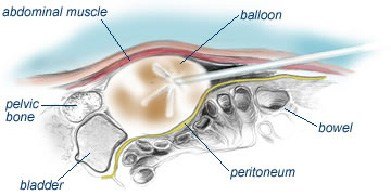
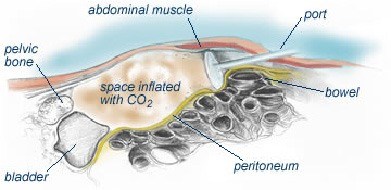
In the keyhole operation, a 1.5 cm (3/4 inch) incision is made just below the umbilicus (bellybutton) and two further tiny incisions are placed between the umbilicus and the pubis. The hernia is identified and pushed back into the abdomen, and the defect repaired with mesh as in the open (non-keyhole) operation.
What are the advantages of a keyhole hernia repair?
The main advantages of laparoscopic (TEP) hernia repair are:
- The small incisions result in less pain, shorter hospitalisation, faster recovery and earlier return to work, especially when hernias are present on both sides.
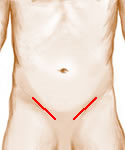
Large incisions for non-keyhole operation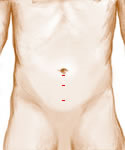
Tiny incisions for keyhole operation
- The positioning of the mesh on the inside of the defect is mechanically better than when placed on the outside as in the non-keyhole operation.
- By positioning the mesh on the inside of the defect, the very sensitive nerves in the inguinal canal are not damaged or irritated by the mesh as can occur in the open approach.
- The keyhole operation is vastly superior to the non-keyhole operation for recurrent hernia.
What can I expect after hernia repair?
After hernia repair surgery, you will be monitored in the recovery room. You may experience pain and soreness, for which your doctor will prescribe medication. You are encouraged to drink liquids, walk and urinate before you are sent home. You will be able to resume your normal activities in a week of the surgery.
What are the outcomes of the hernia surgery?
Hernia surgery is a definitive treatment for groin hernias, having a very low rate of the hernia returning. This rate is much lower when the surgery is performed through keyhole surgery.
What is the cost of the procedure?
We will provide you with a full explanation of the costs of the operation to assist you in your decision to proceed. The costs will vary depending on your level of private health insurance.
How do I choose the best hernia surgeon for my operation? Why should I choose Mr Michael Bickford?
Michael has a major interest in minimally invasive surgery and was a pioneer of keyhole hernia repair surgery in Australia. He has extensive experience wih more than 5000 operations performed.
Questions you should ask your surgeon at the first consultation
How many of these operations have you performed? How many do you do each week?
How often do you need to perform the open technique? What is your rate of hernia recurrence?
Ongoing research on TEP hernia repair include:
- Novotny NM, Puentes MC, Leopold R, Ortega M, Godoy-Lenz J. The Burnia: Laparoscopic Sutureless Inguinal Hernia Repair in Girls. J Laparoendosc Adv Surg Tech A. 2017 Apr;27(4):430-433.
- Ferrarese A, Bindi M, Rivelli M, Solej M, Enrico S, Martino V. Self-gripping mesh versus fibrin glue fixation in laparoscopic inguinal hernia repair: a randomized prospective clinical trial in young and elderly patients. Open Med (Wars). 2016 Nov 26;11(1):497-508.






